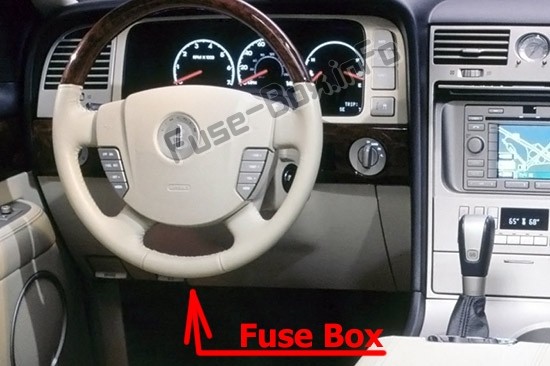The Lincoln Aviator, a luxury SUV that debuted in the early 2000s, is known for its blend of comfort and capability. For owners of the 2004 Lincoln Aviator, understanding the vehicle’s fuse system is crucial for maintenance and troubleshooting. One frequently asked question revolves around the 2004 Lincoln Aviator Obd2 Fuse. This article will provide a detailed guide to help you locate this fuse and understand its function, ensuring your vehicle’s diagnostic system is always ready when you need it.
This guide is tailored for the 2004 Lincoln Aviator (first generation, UN152), but also provides fuse box information relevant to the 2003 and 2005 models within the same generation. Here, you’ll find fuse box diagrams, locations, and the specific assignments for each fuse and relay, with a special focus on the OBD2 fuse.
Understanding Fuse Box Locations in Your 2004 Lincoln Aviator
To begin, it’s important to know where the fuse boxes are located in your 2004 Lincoln Aviator. Typically, vehicles have multiple fuse panels, and the Aviator is no exception. For the 2003-2005 models, the primary fuse locations are in the passenger compartment and the engine compartment.
Passenger Compartment Fuse Box
The main fuse panel inside your 2004 Lincoln Aviator is situated for easy access.
Location
You can find the passenger compartment fuse box under the instrument panel, on the left side of the steering column. Relays associated with this fuse panel are located on its reverse side. Accessing these relays requires removing the fuse panel itself.
Engine Compartment Fuse Box
The engine compartment houses another critical fuse box, protecting circuits related to engine and powertrain functions.
Location
The engine compartment fuse box in the 2004 Lincoln Aviator is readily accessible under the hood. For additional relays, especially those in the rear relay box, it’s recommended to consult a dealer or certified technician for service.
2004 Lincoln Aviator Fuse Box Diagrams and Fuse Assignments
Now, let’s dive into the specifics of the fuse layouts for your 2004 Lincoln Aviator. Below are diagrams and tables detailing the fuse assignments for the instrument panel fuse box and the engine compartment fuse box.
Instrument Panel Fuse Box Diagram for 2004 Lincoln Aviator
The instrument panel fuse box controls many of the interior and accessory functions of your vehicle, including the OBD2 port.
2004 Instrument Panel Fuse Assignments
| Fuse # | Amp Rating | Description |
|---|---|---|
| 1 | 30A | Moonroof motor, Driver seat lumbar switch |
| 2 | 10A | VAPS module, Memory seat module, Body security module, Tire Pressure Monitor System (TPMS), Sunload/Autolamp sensor (SecuriLock LED) |
| 3 | 20A | Radio, Navigation system |
| 4 | 5A | Front wiper module |
| 5 | 15A | Flasher relay (turn/hazards) |
| 6 | 5A | Electronic Hidden Antenna Module (EHAM) (antenna amplifier), Radio, Moonroof motor, Driver window motor, Navigation |
| 7 | 15A | Heated mirrors, DEATC module |
| 8 | 5A | Daytime Running Lamps (DRL) module, Heated PCV valve |
| 9 | 10A | Back-up lamps (DTRS), Electrochromatic mirror |
| 10 | 10A | Heated backlight relay coil, Climate seat modules, Auxiliary A/C temperature blend/mode actuator, A/C clutch relay contact |
| 11 | 20A | Not used (spare) |
| 12 | 15A | Restraints module |
| 13 | 10A | Brake shift interlock |
| 14 | 5A | Not used (spare) |
| 15 | 5A | Instrument cluster, Rear wiper module, TPMS |
| 16 | 20A | Cigar lighter, OBD II |
| 17 | 15A | Delayed accessory relay coil, Battery saver relay coil and contacts |
| 18 | 5A | Not used (spare) |
| 19 | 15A | Washer pump |
| 20 | 5A | Shifter, Clock, Power mirror switch, DVD |
| 21 | 10A | Brake pressure switch (ABS), IVD switch, Flasher relay |
| 22 | 10A | ABS module |
| 23 | 7.5A | Liftgate release relay coil and contacts |
| 24 | 30A | Subwoofer, Navigation |
| 25 | 5A | Trailer tow battery charge relay coil |
| 26 | 5A | SecuriLock transceiver |
| 27 | 5A | Rear park assist, VAPS module |
| 28 | 5A | Radio, Navigation |
| 29 | 10A | DTRS, Feed to Fuse 28 |
| 30 | 5A | Instrument cluster, Compass module, Auxiliary A/C relay coil |


Key takeaway: For the 2004 Lincoln Aviator, the OBD II fuse is located in the Instrument Panel Fuse Box at position #16, and it is a 20 Amp fuse. It’s also shared with the cigar lighter.
Engine Compartment Fuse Box Diagram for 2004 Lincoln Aviator
The engine compartment fuse box protects critical engine and safety systems.
2004 Engine Compartment Fuse Assignments
| Fuse # | Amp Rating | Description |
|---|---|---|
| 1 | 60A | Power Junction Box (PJB) |
| 2 | 30A | Door locks (BSM) |
| 3 | — | Not used |
| 4 | 40 A | Heated backlight/mirrors |
| 5 | 40 A | Anti-lock Brake System (ABS) module (pump) |
| 6 | 60A | Delayed accessory |
| 7 | 20A | Daytime Running Lamps (DRL) module |
| 8 | 20A | Electric cooling fan |
| 9 | 20A | Headlamp switch |
| 10 | 30A | ABS module (valves) |
| 11 | 40A | PTEC relay contacts |
| 12 | 50A | Ignition/Starter relay |
| 13 | 40 A | Trailer tow relays |
| 14 | 15 A | Brake lamp feed |
| 15 | 10A | Keep alive power (PTEC/cluster/DEATC) |
| 16 | 20A | Power point #3 |
| 17 | 20A | Rear wiper module |
| 18 | 20A | 4×4 module |
| 19 | 30A | Driver window motor |
| 20 | 30A | Electric trailer brakes |
| 21 | 30A | Memory seat module |
| 22 | 20A | Main exterior lamps (low beam headlamps, high beam headlamps, fog lamps) |
| 23 | 30A | Ignition switch |
| 24 | 20A | Horn relay |
| 25 | 20A | Power point #1 |
| 26 | 20A | Fuel pump relay contacts |
| 27 | 20A | Trailer tow lamps |
| 28 | 20A | Power point #2 |
| 29 | 60A | PJB |
| 30 | 30A | Front wiper module |
| 31 | 30A | Climate-controlled seats modules |
| 32 | 30A | Passenger seat switch |
| 33 | 30A | Auxiliary blower motor |
| 34 | 20A | Right HID relay |
| 35 | 20A | Left HID relay |
| 36 | 40 A | Blower motor |
| 37 | 15 A | A/C clutch relay, TXV, Transmission, Speed control |
| 38 | 15 A | HEGO, VMV, Canister vent, IMCC-LSRC, EGR module |
| 39 | 15 A | Injectors |
| 40 | 15 A | PTEC, Mass Air Flow (MAF) sensor, Fuel pump relay |
| 41 | 25A | Coil on plug, PTEC relay |
| 42 | 10A | Right low beam (halogen) |
| 43 | 10A | Left low beam (halogen) |
| 44 | 2A | Heated PCV valve (w/DRL only) |
| 45 | 2A | Brake Pressure Switch |
| 46 | 20A | High beams/Fog lamps |
| 47 | — | Horn relay |
| 48 | — | Fuel pump relay |
| 49 | — | High beam relay |
| 50 | — | Fog lamp relay |
| 51 | — | Not used |
| 52 | — | A/C clutch relay |
| 53 | — | Trailer tow right turn relay |
| 54 | — | Trailer tow left turn relay |
| 55 | — | Blower motor relay |
| 56 | — | Starter motor relay |
| 57 | — | PTEC relay |
| 58 | — | Ignition relay |
| 59 | — | Driver brake applied relay |
| 60 | — | PCM diode |
| 61 | — | A/C clutch diode |
| 62 | 30A | Power windows (Circuit breaker) |
Understanding the OBD2 Fuse Function and Troubleshooting
The On-Board Diagnostics II (OBD2) system is vital for modern vehicle diagnostics. It allows mechanics and vehicle owners to access a wealth of information about the vehicle’s health and performance using a scan tool. The OBD2 port needs power to function, and this power is protected by a fuse.
Function of the OBD2 Fuse
The OBD2 fuse, in the 2004 Lincoln Aviator, is primarily responsible for providing power to the OBD2 diagnostic port. When this fuse is blown, you might experience:
- OBD2 Scanner Not Powering On: The most common symptom is that your OBD2 scan tool will fail to power up when plugged into the port.
- Inability to Read Diagnostic Codes: Even if the scanner powers on, it may fail to communicate with the vehicle’s computer to retrieve diagnostic trouble codes (DTCs).
- Cigar Lighter Malfunction: Since the OBD2 fuse is shared with the cigar lighter (power outlet), you may also notice that your cigar lighter or power outlet is not working.
Troubleshooting and Replacing the OBD2 Fuse
If you suspect a blown OBD2 fuse, here’s how to troubleshoot and replace it:
- Locate the Instrument Panel Fuse Box: Refer to the location described earlier in this article.
- Identify Fuse #16 (20A): Using the diagram and table provided, locate fuse number 16 in the instrument panel fuse box.
- Check the Fuse: Visually inspect the fuse. A blown fuse typically has a broken wire inside or signs of melting. You can also use a fuse tester for a more accurate check.
- Replace the Fuse: If the fuse is blown, replace it with a new 20 Amp fuse. Ensure you use the correct amperage to avoid further electrical issues.
- Test the OBD2 Port and Cigar Lighter: After replacing the fuse, test your OBD2 scanner and the cigar lighter to see if they are now functioning.
Caution: Repeatedly blowing fuses indicates an underlying electrical problem that needs professional diagnosis. Do not simply keep replacing fuses without investigating the root cause.
Conclusion
Knowing the location and function of the 2004 Lincoln Aviator OBD2 fuse is essential for maintaining your vehicle’s diagnostic capabilities. Fuse #16 (20A) in the instrument panel fuse box is the key fuse to check if you are experiencing issues with your OBD2 port or cigar lighter. By using this guide, you can confidently troubleshoot and address common fuse-related problems in your 2004 Lincoln Aviator, ensuring your vehicle remains in top condition. Always refer to your vehicle’s owner manual for the most accurate and detailed information, and consult a certified technician for complex electrical issues.
Disclaimer: This article is for informational purposes only and should not be considered professional automotive advice. Always consult a qualified technician for vehicle repairs and maintenance.
Learn more about automotive fuses:
How to check the fuses?
How to replace a blown fuse?
Why do car fuses blow?
Types of automotive fuses
